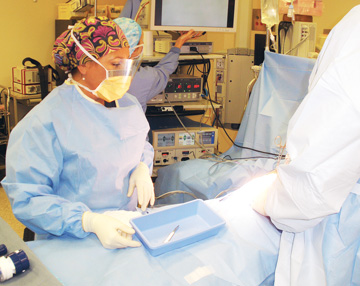• Regular audits. Perform a sharps safety audit each quarter to ensure all needle safety and infection prevention policies are being performed correctly and none of your staff become complacent, rush or cut corners — something that’s especially important when cases are on the rise. As cases increase, so does the risk for sharps injuries — all the more reason for quarterly audits.
• Ongoing training. Provide sharps prevention and bloodborne pathogen safety training during new employee orientation, but also provide a yearly refresher course for other staff. Even though our lone sharps injury involved a solid core needle that hadn’t yet come in contact with the patient, we take the risk of bloodborne pathogens very seriously and have a clear-cut post-needlestick procedure as well as a standard reporting protocol.
When it comes to training and educational sessions, try to lean on the expertise of your staff. For instance, many of our nurses have been practicing for more than 30 years. We encourage them to use these trainings as a platform to speak up about what they’ve experienced. Maybe one of your nurses suffered an injury or had a close call at a previous facility and could provide invaluable advice for the rest of the staff. Your frontline staff is a wealth of knowledge and experience; you just need to make sure to provide a safe, welcoming space for them to share their insights.
One last note on sharps safety training: It doesn’t need to be overly complicated, but it should explain to your staff why your protocols and policies are in place — and what the risks are for unsafe practices. For instance, approximately 385,000 needlesticks and other sharps-related injuries affect healthcare personnel, according to the CDC. If your staff understand why your protocols are in place, they are more likely to follow them. And if you receive pushback from any staff during training, that could be helpful as well. After all, if staff are grumbling over sharps safety protocols, how can you get them onboard and how many other policies are they not going to follow?
After training, we test our employees’ knowledge with a nine-question true or false quiz (see “Test Your Sharps Safety Knowledge” below) led by our administrator and our director of nursing. We use this quiz as another touchpoint to remind staff to be mindful of sharps safety, as these injuries are the number one safety risk for healthcare staff.
• Proper disposal. While most people think of sharps injuries as incidents that occur during handoffs in the middle of surgery, plenty of problems occur during the disposal of these items, as well. That’s why you must ensure sharps are properly disposed of and only placed in puncture-proof sharps containers immediately after use.
.svg?sfvrsn=be606e78_3)

.svg?sfvrsn=56b2f850_5)